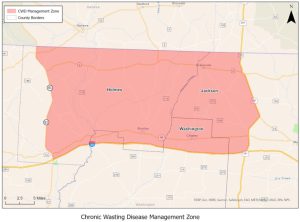Chronic Wasting Disease
Chronic Wasting Disease is a contagious disease of the brain and central nervous system that is fatal to members of the deer family including deer, elk, moose, and caribou. An informative fact sheet can be seen here: What is Chronic Wasting Disease (CWD)? (myfwc.com)
The disease is caused by a prion, or a protein that is abnormal and misfolded. These prions spread throughout the body of the deer cause damage to normal proteins. Over the course of a few years, deer become emaciated and exhibit abnormal behavior. Once symptoms appear, death is certain within months.
“Currently, there is no scientific evidence that CWD can be transmitted to humans or livestock under natural conditions. However, the Centers for Disease Control and Prevention do not recommend consuming meat from animals that test positive for CWD or from any sick animal. The FWC provides information about precautions people should take when pursuing or handling deer that may have been exposed to CWD. ” – Florida Fish and Wildlife Conservation Commission.
Symptoms of Chronic Wasting Disease in Deer
Symptoms of CWD generally appear 1.5 to 3 years after the deer becomes infected, which is characterized by abnormal deer behavior, extreme weight loss, walking in circles, and inattentiveness to people. Upon manifestation of these symptoms, death usually occurs within four months to one year.
Prion Persistence in the Environment
Prions are released into the environment through animal excreta, feces, urine, saliva, etc. and decomposing carcasses and aid disease incidence which can build up to levels of greater than 50% of a herd. Animals shed infective prions while still being asymptomatic, making it difficult to control. In addition, prion infectivity persists for long periods of time in the environment, having a higher content of beta-sheet structure and showing resistance to desiccation, drying, and can be buried in soil up to 5 years and even longer in aqueous environments. Prions have even been reported to survive wastewater treatment (Hinckley et al. 2008)
According to the CDC, other prion diseases in animals include:
- Bovine Spongiform Encephalopathy (BSE)
- Scrapie
- Transmissible mink encephalopathy
- Feline spongiform encephalopathy
- Ungulate spongiform encephalopathy
Frequently Asked Questions (FAQ’s) about CWD can be found here: About CWD | FWC (myfwc.com)
CWD has been recorded in more than half of the states in the US and many provinces in Canada. See map below:

Executive Order & CWD Management Zone
Florida Fish and Wildlife Conservation Commission announced that a road-killed deer in Holmes County, Florida tested positive for chronic wasting disease, a contagious disease of the brain and central nervous system fatal to members of the deer family including deer, elk, moose, and caribou.
Executive order EO 23-12 was signed by FWC Director, Roger A. Young on June 19th, 2023 for: “Establishment of a chronic wasting disease (CWD) management zone and special regulations for deer”.
The original message circulated by FWC can be seen here: IMPORTANT MESSAGE TO FLORIDA DEER HUNTERS (govdelivery.com)
“The FWC is asking anyone who sees a sick, abnormally thin deer or finds a deer dead from unknown causes to call the CWD hotline, 866-CWD-WATCH (866-293-9282) and report the animal’s location.”

References:
- Glen T. Hinckley, Christopher J. Johnson, Kurt H. Jacobson, Christian Bartholomay, Katherine D. McMahon, Debbie McKenzie, Judd M. Aiken, Joel A. Pedersen. (2008). Persistence of Pathogenic Prion Protein during Simulated Wastewater Treatment Processes. Environ. Sci. Technol. 2008, 42, 14, 5254–5259. June 10, 2008. https://doi.org/10.1021/es703186
- Qi Yuan, Gage Rowden, Tiffany M. Wolf, Marc D. Schwabenlander, Peter A. Larsen, Shannon L. Bartelt-Hunt, Jason C. Bartz. (2022). Sensitive detection of chronic wasting disease prions recovered from environmentally relevant surfaces. Environment International. Volume 166. 107347, ISSN 0160-4120, https://doi.org/10.1016/j.envint.2022.107347.
(https://www.sciencedirect.com/science/article/pii/S0160412022002744)
 2
2
